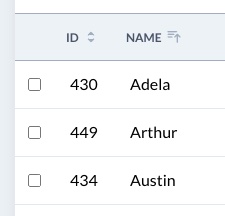# Fields reference
# Defining fields
Each Avo resource has a fields method that registers your resource's fields. Avo ships with a variety of fields like text, textarea, number, password, boolean, select, and others.
To add a field you need to declare it in the fields method like so:
fields do text :name endCopied!
This will create a text input field that will update the name field on that model.
# Field conventions
Avo will convert the snake case version of your field to a humanized version.
In the following example, the is_available id will render the label of the field as Is available.
boolean :is_availableCopied!

If you want to customize the label, you can give it a name that's different from the field itself with the name property.
text :body, name: 'Post body'Copied!

# Showing / Hiding fields on different views
You may want to display a field in the Create and Edit view and hide it Index and Show view. For this you may use hide_on,
show_on, only_on and except_on methods like so. Available options for these methods are: :create, :edit, :index, :show, :forms
(both :create and :edit) and :all (only for hide_on and show_on).
Be aware that some fields are designed in such a way that a few methods or a few options don't work. Check the documentation for fields to find out more!
text :body, hide_on: [:index, :show]Copied!
# Computed Fields
At times you might need to show a field with something else than you have available in the database. In this case, you may compute the value using a block that receives the model (the actual database record), the resource (the Avo configured resource), and the current view. Then you can compute what to show on this field in the Index and Show views.
boolean 'Has written something' do |model, resource, view| model.posts.present? endCopied!
This example will display a boolean field with the value computed from your custom block.
# Fields Formatter
There could be a case where you will want to process the database value before showing it to the user. You may do that using format_using block.
text :is_writer, format_using: -> (value) { value ? '👍' : '👎' }Copied!
This example snippet will make the :is_writer field to generate emojis instead of 1/0 values.

# Sortable fields
One of the most common operations with database records is sorting the records by one of your fields. You leverage the sortable option.
Just add it to any field, and Avo will make that column sortable in the Index view.
text :name, sortable: trueCopied!

# Placeholder
Some fields support the placeholder option which will be passed to the inputs on Edit and New views.
text :name, placeholder: 'John Doe'Copied!

# Required
Sometimes you will want to prevent the user from submitting the form without filling in a field. You may use the required option that will add an asterisk to that field, indicating that it's mandatory.
text :name, required: trueCopied!

However, you will need to add your validation logic to your model (validates :name, presence: true).
# Readonly
Sometimes you will want to prevent the user from editing a field. readonly will render the field as disabled.
text :name, readonly: trueCopied!

# Default Value
When you need to give a default value to your one of your fields on the Create view, you may use the default method, which takes either a fixed value or a block.
# using a value text :name, default: 'John' # using a callback function select :level, options: { beginner: 'Beginner', advanced: 'Advanced' }, default: -> (model, resource, view, field) { Time.now.hour < 12 ? 'advanced' : 'beginner' }Copied!
# Help text
Sometimes you will need some extra text to explain better what the field is used for. You can achieve this by using the help method.
The value can be either text or HTML.
# using text value code :custom_css, theme: 'dracula', language: 'css', help: "This enables you to edit the user's custom styles." # using HTML value password :password, help: 'You may verify the password strength <a href="http://www.passwordmeter.com/">here</a>.'Copied!

# Nullable
Regularly, Avo is trying to store a value for each field. There are cases where you may prefer to explicitly instruct Avo to store a NULL value in the database when the field is empty.
To achieve this, you may use the nullable option, which converts nil and empty in NULL.
You may also define which values are interpreted as NULL using the null_values method.
# using default options status :updated_status, failed_when: [:closed, :rejected, :failed], loading_when: [:loading, :running, :waiting], nullable: true # using custom null values textarea :body, nullable: true, null_values: ['0', '', 'null', 'nil']Copied!
# Link to resource
Sometimes, on the Index view, you may want a field in the table to be a link to the resource, so that you don't have to scroll to the right to click on the show icon. You can use link_to_resource to change a table cell to be a link to that resource. You can add this property on Id, Text, and Gravatar fields.
# for id field id link_to_resource: true # for text field text :name, link_to_resource: true # for gravatar field gravatar :email, link_to_resource: trueCopied!

